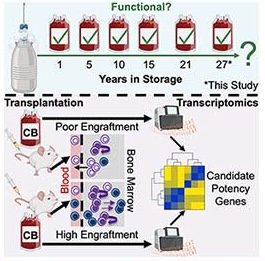Abstract Text: Umbilical cord blood transplantation is a life-saving treatment for malignant and non-malignant hematologic disorders. It remains unclear how long cryopreserved units remain functional, and the length of cryopreservation is often used as a criterion to exclude older units. We demonstrate that long-term cryopreserved cord blood retains similar numbers of hematopoietic stem and progenitor cells compared with fresh and recently cryopreserved cord blood units. Long-term cryopreserved units contain highly functional cells, yielding robust engraftment in mouse transplantation models. We also leverage differences between units to examine gene programs associated with better engraftment. Transcriptomic analyses reveal that gene programs associated with lineage determination and oxidative stress are enriched in high engrafting cord blood, revealing potential molecular markers to be used as potency markers for cord blood unit selection regardless of length of cryopreservation. In summary, cord blood units cryopreserved for extended periods retain engrafting potential and can potentially be used for patient treatment.


